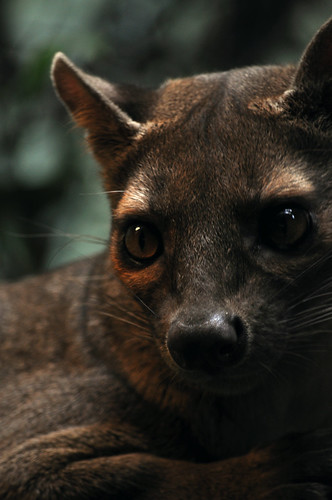I slowly place my boot back down onto the forest floor and cringe at the loud crunch of dried leaves under my foot. Pausing, I scan the quiet trees for a flash of color or flutter of wings, but I really hope to see the shaking of branches signaling a group of lemurs bounding effortlessly through the canopy. Flies, attracted by the stench of rotting meat, buzz around the bait bucket, breaking the silence of the mid-afternoon heat. There’s a reason the person assigned to tote the bait is relegated to the back of the census group: the bait has certainly matured, turning from raw red to a putrid gray, perfectly ripe for fossa.As we approach the next trap on the forest grid, I wait with other volunteers as a staff member inches quietly toward the metal cage. The trap would rattle frantically if we’d caught an animal, but it remains still. “Time: 4:30; Bait: Good; Trap: Closed.” Something has been tampering with it, though we didn’t catch the culprit. “Let’s add some bait anyway. Hopefully, the fossa won’t be able to resist all this meat.”
Similar in appearance to a miniature puma, the fossa (Cryptoprocta ferox) is Madagascar’s largest predator, and – not surprisingly – it has an infamous and undeserved reputation. As a top predator, the fossa is a keystone species that plays an essential role in the Madagascan ecosystem. It is listed as vulnerable by the International Union for Conservation of Nature (IUCN), as deforestation and competition with feral dogs and other non-native carnivores threaten the fossa’s tenuous populations found throughout the country.
Madagascar is an island nation located off the southeastern coast of Africa in the Indian Ocean. The island contains a treasure trove of flora and fauna; 80 percent of its wildlife and 90 percent of its plant life exist only in this biodiversity-rich hotspot. Tenrecs, aye ayes, chameleons, ploughshare tortoises and, of course, the famous and charismatic lemurs all call Madagascar home. While one of the richest countries in terms of biodiversity, the Red Island – so called for its rust-colored soil – remains one of the poorest nations in the world. But development is taking its toll on this island and its curious fossa: as much as 90 percent of the country’s fragile forests are now gone.
I set the bucket down, open the trap and fling a piece of rotting meat into the back of the cage. I take the stick securing the piece of meat already there and pierce a fresh piece on top of it. Once I’ve staked the bait, I reset the trap. We proceed slowly along the grid, checking traps for fossa, freshening bait and recording any vertebrates we encounter. The quiet whooping and subsequent sighting of the hoopoe – a red-headed bird with black and white zebra-like plumage – stops our group in its tracks; the scribe notes the number of individuals seen, as well as their height and distance from the trail. The light between the trees illuminates the innumerable vines and branches, bestowing a soft, otherworldly haze onto the Malagasy forest.
Checking traps for predators is just one of the responsibilities of volunteers and staff on this conservation and research project. Studying and monitoring the fossa population with Dr. Luke Dollar, a National Geographic Explorer, in Madagascar’s Ankarafantsika National Park also involves conducting a population census of fossa. Once a fossa has been trapped, it is tranquilized and brought back to the research base camp, where the lead scientist and veterinarian collect blood and tissue samples, take morphological measurements, and tag it in order to identify the individual in the future.
The project’s goals spread far beyond basic recording and tracking. Prior to Dr. Dollar’s work, very little was known about the elusive fossa. Many local Malagasy people were afraid of the animals, and folk stories abound that turned the fossa – completely harmless to humans and they’re large livestock – into Madagascan boogeymen. However, since the commencement of the research, the team has discovered that fossa actually help control populations of rats, pigs and other pests that damage crops and diminish yields. Volunteers and scientists spend time attempting to educate people and change minds about this helpful predator using culturally-sensitive, anthropologically-based techniques. Posters with the project’s mantra – “arovynyfossa, arovynyvokotra” or “save the fossa, save the harvest” – have been distributed throughout the country, and Malagasy people now teach one another to respect and help protect the fossa.
I went to Madagascar expecting to see an amazing range of wildlife in natural habitats. And I did. I also expected this would be the high point of my trip. But it wasn’t. Holding a fossa, spotting lemurs and observing chameleons were all incredible experiences I cherish, but my most meaningful memories are those of the people. Speaking, in my limited Malagasy, to the women who cooked for us, waving salama to people I encountered walking to and from trap checks, learning about the lives of girls in Ankarafantsika, and spending time with the Malagasy university students – these are the memories that make me yearn to return to the Red Island.
To read the entire article written by Julia Osterman, visit Izilwane. Find out how you can become involved as a fellow “citizen eco-reporter” and contribute to our mission of spreading the word about biodiversity loss. Watch the video below for more information about Luke Dollar and the disappearing Fossa.





Aucun commentaire:
Enregistrer un commentaire